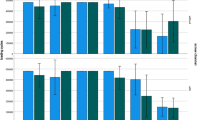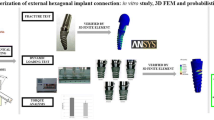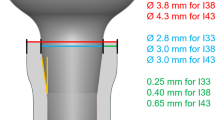Abstract
The purpose of this study was to investigate the relationship between implant fracture under cyclic-fatigue loading at different embedding angles, embedding depths, and loading forces. Twenty-four cylinder-type implants 3.3 mm in diameter and 10 mm in length were used. Test specimens were 30 mm3 resin blocks with one surfaces inclined at angles of either 5°, 10°, 15° and 20° and embedded vertically with implants at depths of either 5 or 10 mm to the these surfaces. A straight abutment was connected to the implant and cut to 5 mm in length, and a hemispherical crown 5 mm in diameter and 7 mm in length was cast with a 12 % gold–silver–palladium alloy and cemented onto the abutment. Each specimen was mounted onto a fatigue loading device to apply repeated vertical loads of 294, 392, and 490 N to the coronal edge of the crown 60 times per min until reaching 100,000 cycles. For each respective specimen, we recorded the combined conditions of embedding and loading forces and the number of loading cycles until fracture, and then observed the fracture sites microscopically. The number of loading cycles until implant fracture tended to decrease in proportion to increased loading forces and embedded angles, and decreased embedded depths. Implant fracture was observed at angles of inclination over 10°. For specimens with an implant embedded at a depth of 5 mm, almost all fractures occurred at the center of the implant body; however, for those embedded at a depth of 10 mm, fractures occurred at the interface between the implant body and the abutment. These results demonstrate that implant fracture is associated with the loading axis, the amount of loading, and the embedded depth of the implant.





Similar content being viewed by others
References
Jemt T. Failure and complications in 391 consecutive inserted fixed prostheses supported by Brånemark implants in edentulous jaws: a study of treatment from the time of prosthesis placement to the first annual checkup. Int J Oral Maxillofac Implants. 1991;6:270–6.
Lekholm U, Van Steenberghe D, Herrmann I, et al. Osseointegrated implants in the treatment of partially edentulous jaws: a prospective 5-year multicenter study. Int J Oral Maxillofac Implants. 1994;9:627–35.
Zarb GA, Schmitt A. The longitudinal clinical effectiveness of osseointegrated implants: the Toronto study. Part III: problems and complications encountered. J Prosthet Dent. 1990;64:185–94.
Goodacre CJ, Bernar G, Rungcharassaeng K, Kan JYK. Clinical complications with implants and implant prostheses. J Prosthet Dent. 2003;90:121–32.
Green NT, Machtei EE, Horwitz J, Peled M. Fracture of dental implants: literature review and report of a case. Implant Dent. 2002;11:137–43.
Balshi T. An analysis and management of fractured implants: a clinical report. Int J Oral Maxillofac Implants. 1996;11:660–6.
Schwarz MS. Mechanical complications of dental implants. Clin Oral Implants Res. 2000;11(Suppl 1):156–8.
Eckert SE, Meraw SJ, Cal E, Ow RK. Analysis of incidence and associated factors with fractured implants: a retrospective study. Int J Oral Maxillofac Implants. 2000;15:662–7.
Perriard J, Wiskott WA, Mellal A, Scherrer SS, Botsis J, Belser UC. Fatigue resistance of ITI implant-abutment connectors—a comparison of the standard cone with a novel internally keyed design. Clin Oral Implants Res. 2002;13:542–9.
Steinebrunner L, Wolfart S, Ludwig K, Kern M. Implant-abutment interface design affects fatigue and fracture strength of implants. Clin Oral Implants Res. 2008;19:1276–84.
Japan Industrial Standard. Zinc phosphate dental cement, T6602, 1993.
ISO 14801:2007. Dentistry—Implant—Dynamic fatigue test for endosseous dental implants.
ASTM E486-90:2004 Standard practice for presentation of constant amplitude fatigue test results for metallic materials.
Takamizawa T. Studies on the co-relative and individual biting forces of normal permanent teeth. J Jpn Prosthodont Soc. 1965;9:217–36.
Goodacre CJ, Kan JY, Rungcharassaeng K. Clinical complications of osseointegrated implants. J Prosthet Dent. 1999;81:537–52.
Green NT, Machtei EE, Horwitz J, Peled M. Fracture of dental implants; literature review and report of a case. Implant Dent. 2002;1:137–43.
Morgan MJ, James DF, Pilliar RM. Fractures of the fixture component of an osseointegrated implant. Int J Oral Maxillofac Implants. 1993;8:409–14.
Rangert B, Krogh P, Langer B, Van Roekel N. Bending overload and implant failure: a retrospective clinical analysis. Int J Oral Maxillofac Implants. 1995;10:326–34.
Huang HW, Tsai CH, Chang CC, Lin CT, Lee SY. Evaluation of loading conditions on fatigue-failed implants by fracture surface analysis. Int J Oral Maxillofac Implants. 2005;20:854–9.
Dittmer MP, Dittmer S, Borchersh L, Kohorst P, Stiesch M. Influence of the interface design on the yield force of the implant-abutment complex before and after cyclic mechanical loading. J Prosthodont Res. 2012;56:19–24.
Chan HL, Oh WS, Ong HS, Fu JH, Steigmann M, Sierraalta M, Wang HL. Impact of implantoplasty on strength of the implant-abutment complex. Int J Oral Maxillofac Implants. 2013;28:1530–5.
Author information
Authors and Affiliations
Corresponding author
Ethics declarations
Conflict of interest
The authors are provided dental implants for the experiments from Dentsply Friadent. The authors declare that they have no other conflict of interest.
Rights and permissions
About this article
Cite this article
Suzuki, H., Hata, Y. & Watanabe, F. Implant fracture under dynamic fatigue loading: influence of embedded angle and depth of implant. Odontology 104, 357–362 (2016). https://doi.org/10.1007/s10266-015-0228-z
Received:
Accepted:
Published:
Issue Date:
DOI: https://doi.org/10.1007/s10266-015-0228-z




